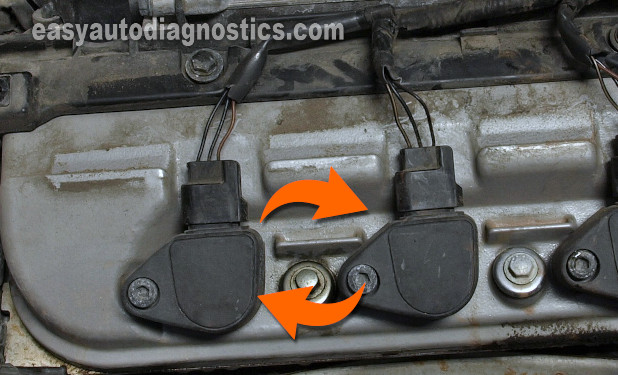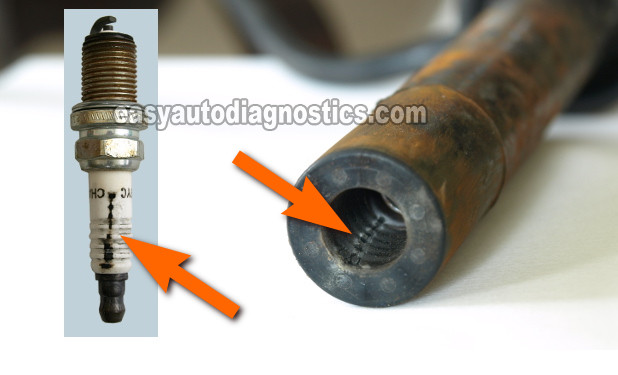TEST 4: Testing For The Presence Of The Triggering Signal

OK, you're here because you have confirmed that you've got an ignition coil that is not sparking, but that it is receiving 12 Volts and Ground.
The next step is to verify that that ignition coil (that's not sparking) is receiving the Triggering signal from the fuel injection computer.
There are two ways of doing this test, with a multimeter that can read Hertz frequency or just by swapping coils. If you just want to test them by swapping COP coils, go to: TEST 5: Testing The Triggering Signal Without A Multimeter.
Testing for the Triggering Signal should be done with the ignition coil connected to its connector. I recommend using a back probe or a wiring piercing probe to access the signal within the wire. You can see an example of this tool here: Wire-Piercing Probe.
These are the test steps:
- 1
Place the multimeter in Hertz (Hz) mode.
- 2
Reconnect the ignition coil to its electrical connector.
- 3
Probe the wire labeled with the number 3 with the black multimeter test lead using an appropriate tool to pierce the wire or to back-probe the connector.
- 4
Connect the red multimeter test lead to the battery positive (+) terminal.
- 5
Crank and start the engine.
- 6
You should see fluctuating values of 30 to 60 Hertz as the engine starts and runs on your multimeter.
Let's examine your test result
CASE 1: The multimeter registered 30 to 60 Hertz (Hz) as the engine cranked and started. This is the correct test result and confirms that the Triggering signal is present.
You can conclude that this particular Coil-On-Plug ignition coil on your Honda is bad and needs to be replaced if you have:
- Confirmed that it's not sparking (TEST 1).
- Confirmed that it's getting 10 to 12 Volts (TEST 2).
- Confirmed that it's getting Ground (TEST 3).
- Confirmed that it's getting an activation signal (this test section).
CASE 2: The multimeter DID NOT register 30 to 60 Hertz (Hz) as the engine cranked and started. Re-check all of your connections and repeat the test again.
If still no Hertz readings, then this results eliminates the ignition coil as the source of the no-spark condition/misfire, since without the Triggering signal the ignition coil will not work.
TEST 5: Testing The Triggering Signal Without A Multimeter

Making sure that the Triggering Signal is present can be done without a multimeter and it simply involves swapping out the non-sparking ignition coil with a good-sparking ignition coil.
If the good-sparking ignition coil sparks when connected to the non-sparking ignition coil's electrical connector, then you can conclude that the Triggering signal is present in the connector.
Let's get testing:
- 1
Remove the COP coil that did not spark and set it aside.
- 2
Remove one of the adjacent COP ignition coils that does spark.
- 3
Now connect the COP ignition coil (that sparks) to your HEI spark tester and then connect it to the electrical connector of the COP coil that does not spark.
- 4
When all is ready, have your trusty assistant crank the engine.
- 5
The good ignition coil should spark.
Here are the test result interpretations:
CASE 1: You got spark. This is the correct test result and confirms that the Triggering Signal is present.
You can conclude that this particular Coil-On-Plug ignition coil on your Honda is bad and needs to be replaced if you have:
- Confirmed that it's not sparking (TEST 1).
- Confirmed that it's getting 10 to 12 Volts (TEST 2).
- Confirmed that it's getting Ground (TEST 3).
- Confirmed that it's getting an activation signal (this test section).
CASE 2: You got NO spark. Re-check all of your connections and repeat the test again. If still no spark, then this results eliminates the ignition coil as the source of the no-spark condition/misfire, since without the Triggering Signal the COP ignition coil will not work.
TEST 6: Checking For Carbon Tracks

If all of the ignition coils fired off spark in TEST 1 and yet the vehicle is experiencing a misfire condition, then the most likely causes are: 1) the spark plug boots spark plugs have developed carbon tracks or 2) the spark plugs and spark plug boots are swimming in engine oil or 3) both of the aforementioned conditions. All of these conditions are a very common occurrence in this type of Coil-On-Plug ignition system.
If the spark plug boots and spark plugs are swimming in engine oil, it's usually due to the valve cover gasket leaking oil into the spark plug tubes. This oil will cause the ignition system to misfire and/or cause carbon tracks to form as the spark cooks the oil.
In the image above, you can see what a carbon track looks like on the spark plug boot and on the spark plug. The next step is to remove the spark plugs and spark plug boots to visually inspect them for carbon tracks and/or to see if they are all oil-soaked.
If the spark plugs are oil-soaked and/or with carbon tracks, you'll need to replace them all along with the spark plug boots. Failure to replace one without the other will only make the carbon track return and/or continue to misfire still.
What If No Carbon Tracks Or Cracks Exist?
Now, if no carbon tracks are visible on any of the spark plugs, or spark plug boots, then the ignition system is not the cause of your misfire condition. I would check engine compression and the fuel injectors among several things.
The following test tutorials may be of help:
- How To Test Engine Compression (Honda 3.0L) (at: troubleshootmyvehicle.com).
- How To Test Misfire Codes (Honda 3.0L) (at: troubleshootmyvehicle.com).
- How To Troubleshoot A No Start (Honda 3.0L) (at: troubleshootmyvehicle.com).

If this info saved the day, buy me a beer!

